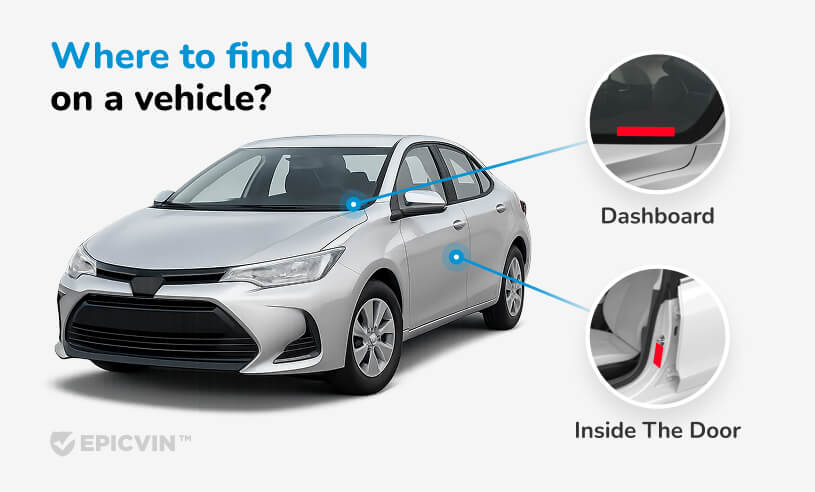
How to Read a VIN Number Like a Pro
From understanding the VIN number breakdown to uncovering a vehicle’s history,...

Free Jeep VIN Decoder! 🚗 See specs, build sheet, recalls basic history—no sign-up. 🛡️✅ Need accidents, mileage, title? Upgrade in one click.
Looking for the VIN?
Here is there you’ll find it:

A vehicle identification number (VIN) means your vehicle's unique 17-character fingerprint. This sequence was officially standardized in 1981. It reveals factory specifications, recalls, and ownership history. Your vehicle's VIN contains critical data that helps verify vehicle specifications, manufacturer details, and vehicle brand information. Using our VIN Decoder assists in verifying vehicle specs and uncovers critical details before purchasing any used car.
Our free VIN decoder makes checking your vehicle's VIN history simple and fast. This VIN decoder tool provides instant VIN lookup results.

Locating your vehicle identification number (VIN) is straightforward. The code appears in multiple locations on your vehicle.
| Risk | Statistics | Advice |
|---|---|---|
| Theft | Cherokee/Grand Cherokee top-10 target (13,200 stolen) | Use comprehensive insurance, an immobilizer |
| Open Recalls | 1 in 5 vehicles, 2 million awaiting repairs | Run a free VIN check, verify repairs done |
| Depreciation | 48% loss after 5 years (Wrangler best at 34%) | Factor into ownership costs |
| Flood/Salvage | 10,000+ branded titles, hundreds flood-tagged | Inspect for water damage, demand a clean title |
| Odometer Fraud | 75,000 vehicles with suspect mileage | Compare the history report with the service records |
| Issue | Models & Symptoms | Repair Cost |
|---|---|---|
| \"Death Wobble\" | Wrangler JK/JL, Gladiator - violent steering shake at 45-65 mph | $450–$1,500 |
| Oil-cooler leaks | 3.6L Pentastar engine ('12-'25) - oil puddles, burning smell | $360–$480 |
| Transmission failure | 9-speed ZF - harsh shifts, delayed engagement, limp mode | $1,000–$6,300 |

Here's the standard VIN format:
Here's how our VIN decoder interprets a sample sequence (1C4BJWDG8GL123456) using VIN lookup technology:
| Symbols | Sample | What It Reveals |
|---|---|---|
| 1 | 1 | The United States as the country of origin |
| 2 | C | Chrysler as a manufacturer |
| 3 | 4 | Jeep brand division |
| 4-8 | BJWDG | SUV body type, engine designation, restraint system, Wrangler model line, trim level |
| 9 | 8 | Check digit for validation |
| 10 | G | 2016 model year |
| 11 | L | Toledo, Ohio assembly plant |
| 12-17 | 123456 | Individual vehicle serial number |
Year 2019
Make Jeep
Model Grand Cherokee
Fuel Type Gasoline
Engine 3.6L V-Shaped
Made in USA
EpicVIN pairs daily DMV data with open-recall lists, letting shoppers spot the 2 million vehicles still waiting for fixes before they buy.Alex Black, CMO at EpicVIN
VIN numbers are public records protected by DPPA laws; no personal information is revealed.
The 11th digit shows the plant assembling the car: L=Toledo, Ohio, J=Jefferson North Detroit, others vary by specific models.
Check the driver's door jamb information panel or engine bay manufacturer plate.
Yes, positions 4-8 reveal the original equipment. They include tow packages and engine specifications.
Compare the dashboard VIN with the door jamb and engine bay. All must match exactly.
Our reports show the vehicle's branded titles, including lemon-law buybacks in vehicle history using VIN information.
Discover expert tips, news and advice on buying and maintaining used vehicles

From understanding the VIN number breakdown to uncovering a vehicle’s history,...

There's an electric van to fit any need or price range. Check out some of the...

A clean title sounds good, but is it enough? Get the facts that sellers might...